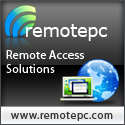More companies are discovering the benefits of using a remote network access program for sharing business information. Remote network access makes it possible for employees, clients, and IT support to access the company’s computer network from any location. Overall, it improves flexibility and productivity of the workplace by providing users with access to files, programs, sales statistics, email, webinars, business presentations, and more, from anywhere that an internet connection is available. Authorized individuals can even remotely control computers within the network, as if they were sitting in front of them.
By allowing employees to view and manage their company’s network from remote locations, they are able do business more efficiently. While traveling, an staff member can still participate in a business meeting that they may otherwise have missed. Plus, if an individual misses an extended period of work due to an illness or emergency, they can use the system to keep up with daily tasks. In fact, companies are sometimes able to save money by managing home-based employees. In some instances, they can even retain employees who permanently moved from the area. Plus, corporations that operate out of multiple facilities can use remote access to network between each division and headquarters.
Video/audio conferencing, webinars, power points, and product demos that are produced within a network can be accessed remotely by employees, business partners, clients, and potential customers. Many remote network access programs even have built-in applications for mass communication. Multiple connections allow sharing to occur with up to an unlimited number of users. A company can train employees in various locations, at the same time, or market a new product to clients, in a cost efficient manner. Information can be delivered all over the world, while preventing unnecessary travel and saving money.
In addition, remote network access can be beneficial for providing efficient IT support to a network of computers. Technical support and repairs are able to be performed for an entire corporation by an IT service professional who works from the other side of the country. Plus, many remote access programs have features that help monitor the health and status of computers within a network, with scans and live updates.
There are also some disadvantages to providing remote access to a network. For one thing, the cost of supplying this feature for a business can be rather expensive. Sometimes companies charge per computer, and certain types of remote access programs require more configurations and maintenance than others. Also, there is always a risk involved when sharing data across the internet. Company files can become vulnerable to breaches in security, and unauthorized users/hackers may gain access to private information. However, there are a number of measures that can be taken to improve the safety of a remote connection.
Numerous programs and applications exist that provide service for remote network access. They each vary in terms features, security, and the the means by which they access a connections. Remote connections to networks can occur through a dialup modem, VPN, or online session screen sharing. A dialup up modem, such as Microsoft RRAS, grants access using dialup, Credentials, or a Smart Card/Certificate Token. Programs such as Cisco and Sonic Wall use a VPN (IPSEC/SSL) connection, which can be accessed by a source/destination IP address, Credentials, or a Smart Card/Certificate Token. Some examples of online screen sharing solutions include LogMeIn, NetViewer, and Citrix Go2Assist.
 Posted in
Posted in  Tags:
Tags: 